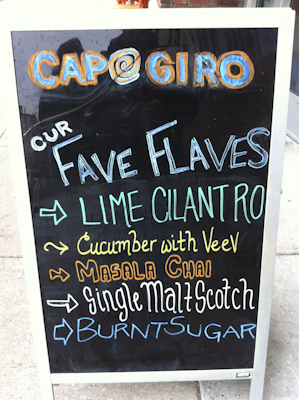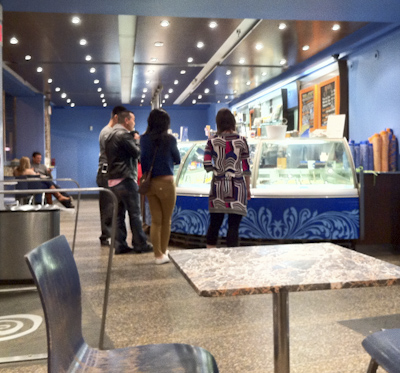Wednesday, April 18, 2012
Our adventure this week was an over-night in Philadelphia, PA. A while ago, I read about a special exhibit of Van Gogh paintings at the Philadelphia Museum of Art this winter called Van Gogh Up Close and thought it would be fun to see the exhibit and visit the ‘City of Brotherly Love’. The first time I went to “Philly” was with two young sons eager to learn about the early history of our country. It must have been in the late 1970s. At that time, we explored the historic district and expressed disappointment that “The Bell” was so small and left outside in the elements. Today the historic district has expanded and modernized and the Liberty Bell has its own indoor museum. We didn’t plan to visit any of the historical tourist sights during this trip.
We left for Philadelphia this morning and had a pleasant three hour drive mostly on the Garden State Parkway. As we approached the city, we saw the tall skyline of new modern-glass and steel buildings. We had booked a room at the Sofitel because it was well located in the downtown center of the city. We checked in and, after a bit of a rest, we went out to explore the immediate neighborhood around the hotel. The section was called Rittenhouse because of a lovely park on the other side of Walnut Street. It was a beautiful sunny afternoon and spring flowers were in full scented bloom. The trees had bright celery-green spring leaves and the birds in the park were happily chirping.
It was good to stretch our legs after a long car ride and we walked along Walnut Street admiring the diversity of architectural styles. In the middle of the traffic grid is the huge Philadelphia City Hall which was built about 1900. It is literally a traffic-stopping structure designed in Second French Empire style and built on the former site of a colonial public square. The architectural style is similar to the ornate Opera Garnier and the Louvre Palace wings in Paris. An interesting bit of trivia is that this City Hall building is currently the second tallest masonry building in the world. This means that it is supported by granite and brick rather than steel.
As we walked along Walnut Street, we passed neoclassical designed buildings complete with ornate columns, as well as high Victorian architecture with gingerbread metal trim. Add to the mix a little Art Deco, a sprinkling of Beaux Arts, and several modern glass skyscrapers. We explored the narrow tree-lined streets near Rittenhouse Square to discover that many of the buildings were traditional brownstones and red-brick Federalist style townhouses of the early 1800s. Downtown Philadelphia seemed like an architectural stroll through time and history.
After a break at Capogiro Gelato Artisans, we walked to the Rosenbach Museum & Library at 2008-2010 Delancey Place. The Rosenbach brothers bought one of the 19th Century townhouses to keep their collections of rare books, manuscripts, and antiques. Dr. Abraham Rosenbach, who was a scholar and the preeminent rare book dealer of his day, helped to create some of the most famous libraries in the U.S. for his wealthy clients. A sample of those libraries are: the Morgan Library in NYC, the Widener Library at Harvard University, the Huntington Library in Los Angeles, CA., and the Folger Shakespeare Library in Washing, DC. Older brother, Philip Rosenbach was an antiques dealer and collector. The house at 2010 Delancey Place is furnished with Philip’s treasures and shows how the brothers lived from 1926-1952 among the 18th century antiques with names such as Hepplewhite and Chippendale.
Visitors are limited to explore only part of the first floor and two rooms on the second floor unescorted. A one hour tour of both houses is included in the admission fee of $10 adults/$8 seniors and is the only way to see the private rooms and libraries. After we paid our admission fee, we were greeted by a volunteer docent, Susan Sklaroff. We were the only guests this afternoon and as a result, we had a private tour of the houses. We were led through security-locked doors and into a reception room. Susan proceeded to tell us about the history of the Rosenbach family, the houses, their relationships, their collections, libraries, and how the family history was woven into the tapestry of Philadelphia history. These were amazing multi-faceted stories and histories which made visiting this museum such a special experience.
After we passed a Samuel Yellin iron gate in the entry hall, we entered the parlor. This was an elegant sitting room with a beautiful Philadelphia highboy near the window and Gratz family portraits on the walls. Susan told us about the Gratz family and their role in early colonial Philadelphia history. The patriarch of the family, Michael Gratz, helped to build the first Synagogue in Philadelphia in 1782. One of his daughters, Rebecca Gratz, founded the Philadelphia Orphan Asylum in 1815 and started a Hebrew Sunday-school run only by women in 1819. Our tour guide, Susan Sklaroff, became so interested in the history of Rebecca Gratz that Susan writes a blog about Rebecca. It is: http://rebeccagratz.blogspot.com
In brief, the Rosenbach brothers lived very well and my description of the house and beautiful collections could not do justice to the elegant furnishings. The museum’s website and wikipedia only give you a peek at the incredible facilities. There was beautiful English silver, part of a miniature portrait collection, paintings, porcelain, stature, and glass. The upstairs rooms house part of Dr. Rosenbach’s library. It was written that there are 130,00 books and manuscripts in the collection. Susan said that most of the rare books are stored within the building’s specially made “stacks”. The Rosenbach Museum & Library website lists many of the rare books, letters, and papers. We saw: Lewis Caroll’s own copy of Alice in Wonderland, Robert Burns’ letters, part of the Charles Dickens collection, James Joyce’s handwritten manuscript of Ulysses, Benjamin Franklin’s first Poor Richard’s Almanac, manuscripts by Shelley, Keats, Oscar Wilde, Conan Doyle, Joseph Conrad, Walter Scott, Wordsworth, and Bram Stoker’s handwritten notes for Dracula, etc., etc., etc…..
 Moka? or Coconut? or Burnt Sugar?
Moka? or Coconut? or Burnt Sugar?
There is also a recreation of Marianne Moore’s Greenwich Village NY living room on the top floor. Moore’s complete library is part of the Rosenbach collection, which includes books by Ezra Pound, T.S. Eliot, Elizabeth Bishop. Finally, the author and illustrator, Maurice Sendak, who is the author of Where the Wild Things Are, chose the Rosenback Museum to be the repository for his works in 1968. 10,000 works of art, illustrations, drawings, manuscripts, and books by Sendak are housed in the Rosenbach Museum. These are on display in continually rotating exhibits of Sendak’s works. During this visit, two rooms were devoted to Maurice Sendak’s illustrations for the 2003 publication of Brundibar. What an amazing jewel of a museum! I look forward to visiting again when we return to Philadelphia.
After so much culture and exposure to so many jaw-dropping books, we worked up an appetite. Jeff consulted his Zagat app and found a small Italian restaurant close by. Viola was just a few blocks away from the museum on a pretty little street off Walnut Street. Up a few steps; pleasant small room; attentive young Italian waiters; limited menu; BYOB. Add to the list: a delicious southern Italian dinner! Jeff had veal and I had a fantastic chicken dish with mushrooms, potatoes, and sugar-snap peas. It was a perfect end to a good day!
(note: iPhone photos)






